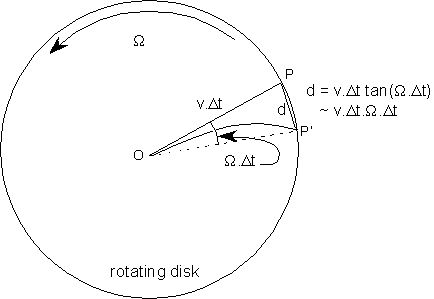The Coriolis acceleration
|
E. Linacre and B. Geerts |
4/'00 |
![]()
|
Consider an object travelling from the centre (point O) towards P on the edge of a rotating disk (Fig 1). It takes time Dt when travelling at speed v, so the distance OP equals v. Dt . However, after a time Dt, P will have moved from its original position (P') to a new position (P). The angle POP' equals t times the speed of rotation of the disk (in radians per second). So for a short displacement the distance d = PP' is: d ~ v. Dt2 .W That sideways distance d is traveled in time t, resulting from a sideways acceleration a, i.e. d = a. Dt2/2 = v.W. Dt2 So the Coriolis acceleration is (1): a = 2.v.W The Earth' rotation rate around the local zenith is We sin l, where l is the latitude and We the Earth's rotation rate (2p/1 day) |
Fig 1. Derivation of the Coriolis force. |
Reference
(1) Scorer, R.S. 1997. Weather & Climate (John Wiley) p.113.
